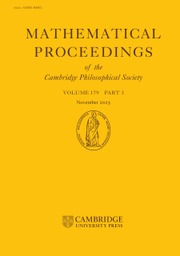No CrossRef data available.
Article contents
Zero-full law for well approximable sets in missing digit sets
Published online by Cambridge University Press: 20 February 2025
Abstract
Let  $b \geqslant 3$ be an integer and C(b, D) be the set of real numbers in [0,1] whose base b expansion only consists of digits in a set
$b \geqslant 3$ be an integer and C(b, D) be the set of real numbers in [0,1] whose base b expansion only consists of digits in a set  $D {\subseteq} \{0,...,b-1\}$. We study how close can numbers in C(b, D) be approximated by rational numbers with denominators being powers of some integer t and obtain a zero-full law for its Hausdorff measure in several circumstances. When b and t are multiplicatively dependent, our results correct an error of Levesley, Salp and Velani (Math. Ann. 338 (2007), 97–118) and generalise their theorem. When b and t are multiplicatively independent but have the same prime divisors, we obtain a partial result on the Hausdorff measure and bounds for the Hausdorff dimension, which are close to the multiplicatively dependent case. Based on these results, several conjectures are proposed.
$D {\subseteq} \{0,...,b-1\}$. We study how close can numbers in C(b, D) be approximated by rational numbers with denominators being powers of some integer t and obtain a zero-full law for its Hausdorff measure in several circumstances. When b and t are multiplicatively dependent, our results correct an error of Levesley, Salp and Velani (Math. Ann. 338 (2007), 97–118) and generalise their theorem. When b and t are multiplicatively independent but have the same prime divisors, we obtain a partial result on the Hausdorff measure and bounds for the Hausdorff dimension, which are close to the multiplicatively dependent case. Based on these results, several conjectures are proposed.
MSC classification
- Type
- Research Article
- Information
- Mathematical Proceedings of the Cambridge Philosophical Society , Volume 178 , Issue 1 , January 2025 , pp. 81 - 102
- Copyright
- © The Author(s), 2025. Published by Cambridge University Press on behalf of Cambridge Philosophical Society


